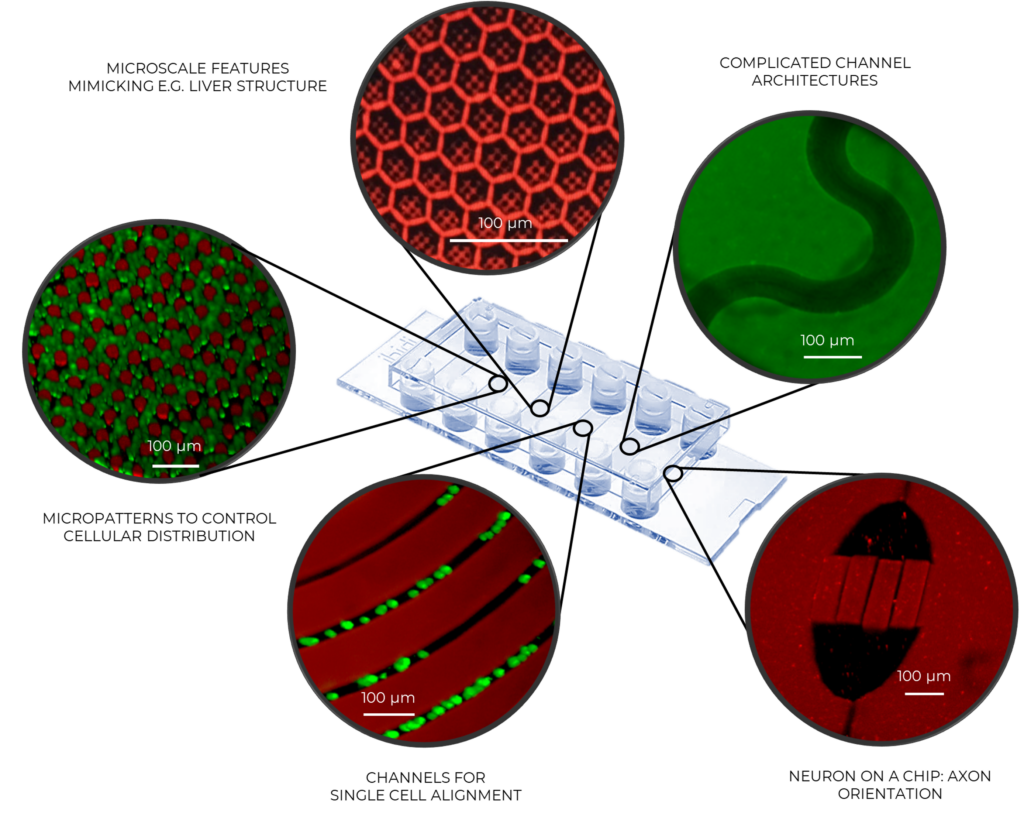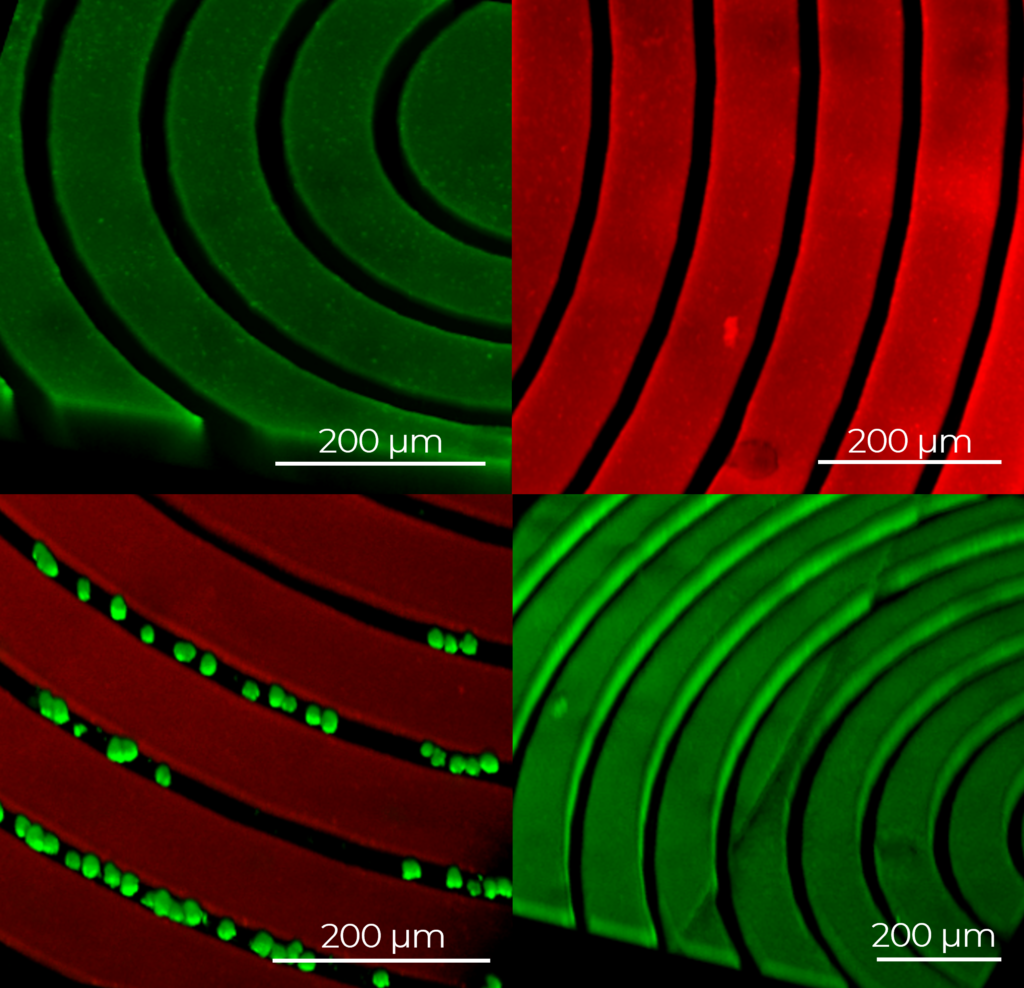New BIO INX Resin Developed for 3D Printing Organs-on-Chips
Belgian startup BIO INX makes all manner of materials for a variety of bioprinting technologies. The latest is Hydrotech INX N200, a biocompatible hydrogel resin developed for two-photon polymerization (2PP), a process capable of making nano- and macro-sized parts through activating photoinitiators in a photoresist with femtosecond laserpulses.
2PP absorbs two photons, which initiate the polymerization reaction and build the structure. 2PP is versatile, can print at very high resolution and has high accuracy. Most of all it can print at the nano and microscale. So one machine could print teeny parts as well as centimeter sized parts or one could make a centimeter part with nanoscale features for example. 2PP has applications in bioprinting, microfluidics, MEMS, optics and beyond. One of the leading firms in 2PP is Nanoscribe, with whom BIO INX collaborated to launch this resin on Nanoscribe’s platform specifically for Dip-in Laser Lithography (DiLL), a 2PP variant.
The material has been tweaked to work well on the Photonic Professional GT2 and Quantum X bio machines from BICO-owned Nanoscribe. The material is ISO-10993-5 certified for biocompatibility, is bio inert, flexible and water-soluble.
BIO INX CEO, Jasper Van Hoorick, said:
“We are thrilled to introduce Hydrotech INX N200, the world’s first two-photon lithography resin enabling macroscale printing. This material represents a significant advancement in bioprinting technology and opens up exciting possibilities for organ-on-chip applications. We are confident that this new material will revolutionize the field of bioprinting and contribute to advancing healthcare worldwide.”
The company sees regenerative medicine, organ on a chip and microfluidics are potential applications. Nanoscribe claims an installed base of over 3500 printers so this gives BIO INX a chance at a market for its material. Its main competitor for that market is BICO itself. At the moment it seems to be selling it exclusively through BICO. The startup is also working on DLP and SLA resins for bioprinting as well. It also has material extrusion based inks such as one that mimics the extracellular matrix, a support material and a low temperature forming polyester. Prices for their materials are steep, $33 a milliliter for one and another goes for $350 a milliliter. At $350,000 a liter this is some of the most expensive stuff on earth, over 43 times more expensive than the famously expensive inkjet ink. Another ink is priced at around $39 a print. Given a small market its no wonder that these bioprinting and microfluidics materials are expensive. Also in a broader sense all science materials are very expensive. Some of this is regulatory oversight and the needs of producing such high tech materials. But, a small market limits those that can use this kind of equipment.
We will need commodity and very inexpensive desktop type bioprinting for bioprinting to really take off worldwide. The challenges are vast and many researchers will help really push bioprinting from the halls of elite universities into our bodies. It is good that BIO INX is making unique high performance bioprinting materials. The company is pushing the market ahead through innovative materials. BICO has done much to consolidate the market and push it ahead also. And that firm has an expansive line up of bio printers from the relatively inexpensive. But, I do think that the path towards true scientific breakthrough and a healthy bioprinting market would be to sell hundreds of thousands of expensive machines to many universities and researchers worldwide.
Subscribe to Our Email Newsletter
Stay up-to-date on all the latest news from the 3D printing industry and receive information and offers from third party vendors.
Print Services
You May Also Like
3D Printing Financials: Prodways Ends 2024 with a Profit
After a tough couple of years, Prodways (EPA: PWG) is starting to bounce back. The French 3D printing company finally made a profit in 2024, improved its operating performance, and...
Blue Origin & Auburn University Use EOS M290 to Study Copper 3D Printing
Blue Origin, the commercial space company built off of investments from Amazon founder Jeff Bezos, has donated two EOS M290 powder bed fusion (PBF) printers to Auburn University’s National Center...
Rocket Lab to Acquire Restructured Laser Communications Provider Mynaric AG
Rocket Lab USA, the Long Beach-based, end-to-end space services company that specializes in producing rockets with additive manufacturing (AM), has announced plans to acquire Mynaric AG, a German provider laser...
3D Printing Financials: Stratasys Ends 2024 with Cost Cuts and Growth Plans
Stratasys (Nasdaq: SSYS) has wrapped up 2024 with stronger margins but a full-year net loss. The polymer 3D printing leader navigated a year of economic headwinds, restructuring efforts, and shifting...





























